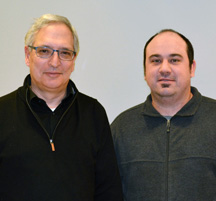Study Shows Path to 'Dialing Down' Autoimmunity without Compromising Immune Response
By Madeline McCurry-Schmidt
A new study led by scientists at The Scripps Research Institute (TSRI) shows how dangerous autoimmune responses, seen in diseases such as lupus and multiple sclerosis, might be “dialed down” without compromising the immune system’s ability to fight viruses and bacteria.
The new study, published in the journal Proceedings of the National Academy of Sciences, defines an unexpected mechanism at work in an anti-autoimmune drug candidate called ozanimod (now under development by Celgene).
“The study uses a proof-of-concept tool compound called CYM-5442,” said TSRI Professor Hugh Rosen, who led the new study with TSRI colleagues Professor Michael Oldstone and Assistant Professor John Teijaro. “With this tool, we show a new, important mechanism in disease that can prevent collateral tissue damage while preserving the protective host response. The findings suggest one could optimize drugs for their ability to suppress this pathway.”
In Success, a Mystery
Rosen has long been interested in a cell membrane protein, called the sphingosine 1-phosphate receptor 1 (S1PR1), as a promising target for autoimmune diseases.
In 2008, Rosen and his colleague, TSRI Professor Ed Roberts, identified a molecule that acts as an S1PR1 receptor “agonist”—inhibiting S1PR1 signaling and blocking a source of inflammation. The discovery led to the development of ozanimod, which is currently in advanced phase 3 clinical trials for multiple sclerosis and ulcerative colitis.
The initial clinical trials, however, led to a surprising observation: some patients responded to treatment even at a very low dose. Could an additional unknown S1PR1 mechanism support the drug’s effectiveness?
“We set out to find this new pathway,” said Rosen.
Discovering the Pathway
By isolating immune cells from mice expressing a fluorescently tagged S1PR1 receptor, the researchers found that S1PR1 agonists directly target immune cells called plasmacytoid dendritic cells (pDCs) to slow the overproduction of proteins known to cause autoimmune disease. Normally, these proteins, type-1 interferons, are helpful, stimulating the body to fight off infections. In autoimmune disease, however, they begin an auto-amplification loop that can make the immune system turn on itself.
When agonists stimulate S1PR1 signaling, the S1PR1 receptor is internalized in a cell structure called a vesicle and may be moved to a different part of the cell for degradation. Using CYM-5442, the researchers found when this happens in pDCs, the migrating S1PR1 induces the type-1 interferon receptor (IFNAR1) to turn over and be degraded as well. “IFNAR1 hitches a ride,” explained Teijaro, who was first author of the new study with TSRI Research Associate Sean Studer.
With the IFNAR1 receptor degraded, type-1 interferons cannot begin the auto-amplification loop. In follow-up experiments, the researchers observed the same phenomenon in human pDCs isolated from donor blood samples.
“Sphingosine 1-phosphate modulation of the interferon auto-amplification loop by induced turnover of the IFNAR1 is a potential mechanism to limit excessive inflammation physiologically,” said Rosen. “Augmentation of this mechanism by drugs like ozanimod may allow the successful treatment of patients with difficult-to-treat autoimmune diseases characterized by iterferon-a signatures, such as subsets of patients with systemic lupus and rheumatoid arthritis.”
Preserving Disease-Fighting Ability
The new study also shed light on the mechanism through which models treated with S1PR1 agonists still recognize and fight off bacteria and viruses, an observation seen in previous studies from the Rosen and Oldstone laboratories.
In the new study, the researchers subjected mouse models to an “immune challenge” by infecting them with the influenza virus. When treated with a S1PR1 agonist, the mouse pDCs still released an initial batch of antiviral type-1 interferon without triggering the auto-amplification loop.
This means the mice fought the infection without overproducing the type-1 interferons that can lead to autoimmune disease.
For human patients, the researchers see a potential advantage in using agonists such as ozanimod to limit immune tissue damage while preserving a patient’s ability to protect against opportunistic infections.
In addition to Rosen, Oldstone, Teijaro and Studer, authors of the study, “S1PR1-mediated IFNAR1 degradation modulates plasmacytoid dendritic cell Interferon-α auto-amplification,” were Nora Leaf, William B. Kiosses and Nhan Nguyen of TSRI; and Kosuki Matsuki, Hideo Negishi and Tadatsugu Taniguchi of the University of Tokyo. See http://www.pnas.org/content/early/2016/01/14/1525356113.abstract
This study was supported in part by National Institutes of Health (NIH) grants MH084512 (Rosen), U54AI057160 to the Midwest Regional Center of Excellence for Biodefense and Emerging Infectious Diseases Research (MRCE), NIH grants AI009484 and AI099699 (Oldstone) and the Donald E. and Delia B. Baxter Foundation Faculty Scholar Grant (Teijaro).
Send comments to: press[at]scripps.edu














